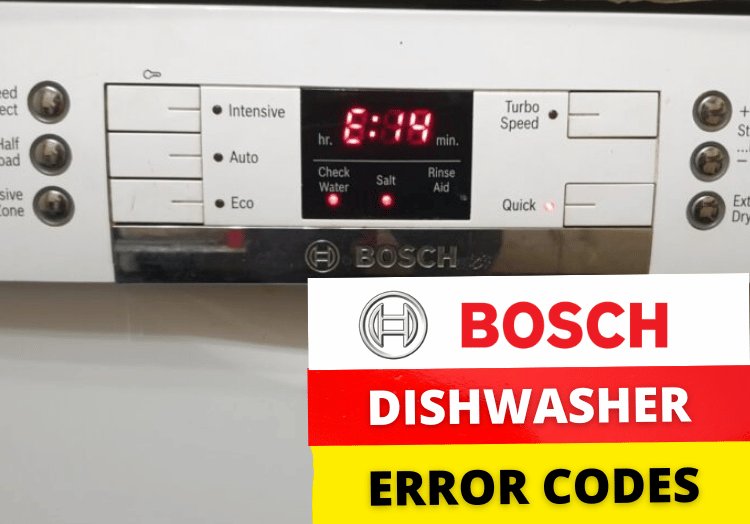
You might be asking yourself, “What’s the big deal?” Well, an error code like F1 could lead to your dishwasher stopping in its tracks, leaving you with a sink full of dirty dishes — not fun! It’s as frustrating as being stuck in traffic when you’re in a hurry. By learning how to avoid this pesky error code, you can ensure that your dishwasher keeps running smoothly, saving you time and hassle down the road. And the best part? You don’t need to be a tech guru to follow these simple, step-by-step solutions.
Understanding the Bosch Dishwasher Error Code F1
First off, let’s dive a little deeper into what the F1 error code really means. In simple terms, this code is your dishwasher’s way of tapping you on the shoulder and saying, “Hey, I’m not getting enough water!” Picture it as your dishwasher being thirsty but unable to find the water fountain. The F1 code is usually caused by an issue with the water inlet, meaning there might be a problem with how water is being supplied to the machine.
Common causes of the F1 error can include a blocked or kinked water hose, a faulty water inlet valve, or even low water pressure. Imagine trying to drink from a straw with a hole in it — not much success, right? These hurdles prevent your dishwasher from getting the water it needs to operate efficiently. Knowing these causes is the first step in preventing the error from popping up again in the future.
So, what does the F1 error actually do to your dishwasher? Essentially, it shuts down the cycle, stopping your appliance from cleaning your dishes. It’s like hitting the pause button on a movie right at the best part — quite annoying! This interruption can disrupt your routine and may even lead to more serious plumbing issues if not addressed. But fear not! Identifying the causes provides a solid foundation for solving them.
Preventing Bosch Dishwasher Error Code F1
Here’s the deal: preventing the F1 error from cropping up again involves a few proactive steps. Think of it as maintaining your car; regular check-ups keep it running smoothly and avoid annoying breakdowns. First, always check the water inlet hose to ensure it’s not twisted or blocked. This hose is like the lifeline for your dishwasher, channeling the water from your home supply into the machine. A simple adjustment or cleaning can often do the trick.
Next, consider examining the water inlet valve itself. This valve acts much like a doorman at a fancy restaurant, controlling who gets in and who doesn’t. If this valve is malfunctioning, it can stop water from entering the dishwasher. Replacing a faulty valve can prevent the F1 error from reoccurring. You might be wondering how to identify a faulty valve. Usually, if there are signs of corrosion or it feels loose, it might be time to change it.
Another tip? Keep an eye on your water pressure. If it’s too low, your dishwasher might not receive enough water to function properly. Imagine trying to fill a bucket with a trickling tap — it takes forever! Checking your home’s water pressure and making necessary adjustments can keep your appliance running like a champ. If you’re unsure about how to check the pressure, a local plumber can always offer assistance.
Long-Term Maintenance Tips
Thinking long-term is key to a stress-free appliance experience. Regular maintenance of your Bosch dishwasher can go a long way in preventing the F1 error and other potential issues. It’s like feeding your pet nutritious food — keeps them healthy and happy! Start by running a monthly cleaning cycle using a dishwasher cleaner. This will help remove any mineral or soap buildup that might impede water flow.
Additionally, routinely inspect the dishwasher’s spray arms and filters. These components need to be clean and free of debris to ensure the water flows freely and washes your dishes effectively. Picture a clogged shower head – it’s quite similar! Remember, keeping these parts in good condition contributes to the overall health of your appliance.
Lastly, be mindful of how you load your dishwasher. Overloading can impede the water’s movement and prevent a proper clean. Imagine trying to stuff a suitcase full of clothes – at some point, it just won’t close! Keeping your loads balanced allows the water, and hence the cleaning, to circulate efficiently. With a little attention to these details, you can enjoy a dishwasher that works well and eliminate those pesky error codes altogether.
By now, you should have a clearer understanding of how to keep the Bosch dishwasher error code F1 at bay. It all boils down to being proactive and addressing potential issues before they become serious problems. Remember, it’s like any routine – a little effort goes a long way! Regular checks on the inlet hose, water valve, and maintaining overall cleanliness will keep your dishwasher happy and running smoothly.
Preventive maintenance is your best friend when it comes to avoiding error codes and ensuring your appliance’s longevity. So next time you load up your Bosch dishwasher, you can do so with confidence, knowing you’re taking the necessary steps to prevent those dreaded disruptions. Here’s to cleaner dishes and fewer headaches in the future!